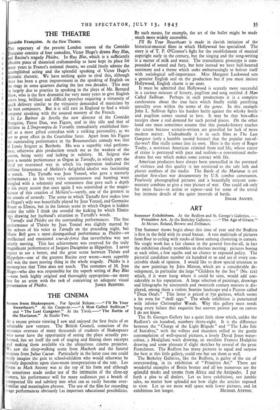THE CINEMA
Scenes from Shakespeare. For Special Release.—" Pit Be Your Sweetheart." At the (aumont.—" A Man Called Sullivan " and " The Last Gangster." At the Tivoli.—" The Battle of the Marianas." At Studio Two.
At a recent private viewing I saw and enjoyed the first fruits of an admirable new venture. The British Council, conscious of the existence overseas of many thousands of students of Shakespeare who never have the opportunity of seeing the plays actually per- formed, has set itself the task of staging and filming short excerpts and making them available via the ubiquitous cinema projector. We saw the sleep-walking scene from Macbeth and the funeral orations from Mitts Caesar. Particularly in the latter case one could easily imagine the gain to school-children who would otherwise be entirely dependent upon class-room interpretations of the text. Leo Genn as Mark Antony was at the top of his form and although he sometimes made undue use of the intimacies of the close-up camera, his performance will for many audiences put a breath of unexpected life and subtlety into what can so easily become over- familiar and meaningless phrases. The use of the film for recording stage performances obviously Las important educational possibilities.
By such means, for example, the art of the ballet might be made much more widely accessible.
I'll Be Your Sweetheart is made in slavish imitation of the historical-musical films in which Hollywood has specialised. The story is of T. P. O'Connor's fight for the establishment of musical copyright early in the century, but the singing and the song-writing is a matter of milk and water. The transatlantic prototype is com- pounded of sound and fury, but here instead we have half-hearted sentiment and a theme which seeks embarrassingly to bolster itself with sociological self-importance. Miss Margaret Lockwood sets a genuine English seal on the production but if you must imitate Hollywood, English charm is no asset.
It must be admitted that Hollywood is scarcely more successful in a curious mixture of history, pugilism and song entitled A Man Called Sullivan. Perhaps in such productions it is a complete carelessness about the true facts which finally yields petrifying unreality even within the terms of the genre. In this example John L. Sullivan fights his hardest battle against the whisky bottle and pugilism comes second to love. It may be that box-office receipts show a real demand for such period pieces. On the other hand one must sometimes assume that this pseudo-history reaches the screen because scenario-writers are gravelled for lack of more modern matter. Undoubtedly it is in such films as The Last Gangster (only a humble second feature) that the popular run-of- the-wee': film really comes into its own. Here is the story of Roger Touhy, a notorious American criminal from real life, whose career of crime is portrayed with pace and realism—a conventional melo- drama but one which makes some contact with life.
American producers have always been unexcelled in the portrayal of violence and this quality is not restricted to the safe lath and plaster confines of the studio. The Battle of the Marianas is yet another first-class war documentary by U.S. combat cameramen. Fearlessly photographed pictures and a beautifully reticent com- mentary combine to give a true picture of war. One could ask only for more faces—in action or repose—and for some of the trivial but intimate details of the quiet intervals of battle.
EDGAR ANSTEY.


























 Previous page
Previous page